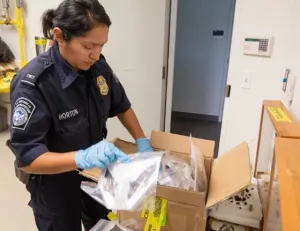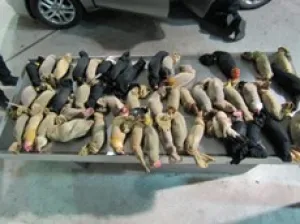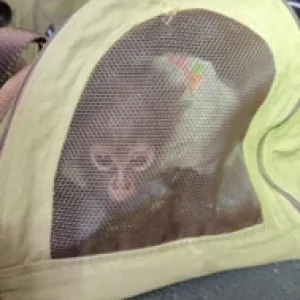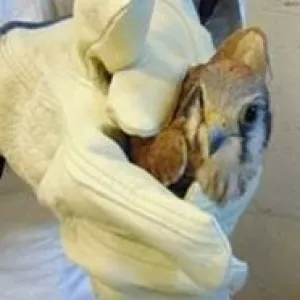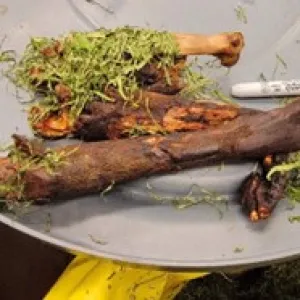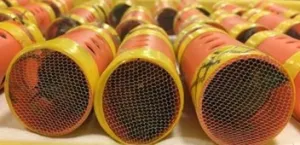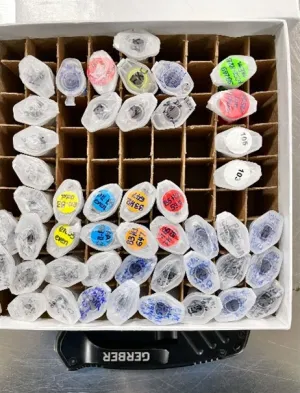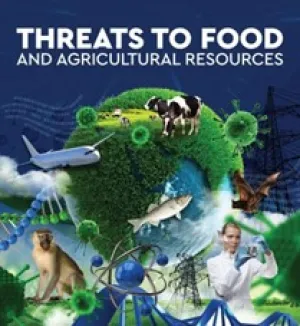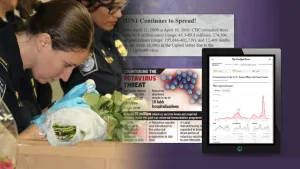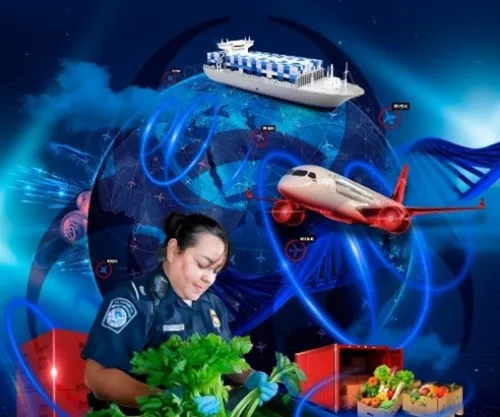Last May, U.S. Customs and Border Protection (CBP) officers assigned to the Port of New York/New York seized numerous vials and vacuum sealed bags with unknown organic materials from a U.S. citizen traveling outbound to Narita, Japan. The subject identified himself as a professor at a public university, focused on stem cell research, and stated the samples were manufactured in a U.S. lab.
Similar cases are happening all too often around the U.S., posing a serious threat to public safety, the U.S. economy, and American agriculture. As CBP continues to encounter biological materials, Office of Field Operations’ (OFO) vigilant workforce — CBP agriculture specialists (CBPAS), CBP officers, Tactical Terrorism Response Team members, Agriculture Programs and Trade Liaison (APTL) staff, and more — are at the forefront of preventing the entry and mitigating risks of biological threats.
But OFO’s response to biothreats starts with policy directives to set the standards of performance and framework of legal authorities to follow during enforcement operations.
As part of the Agro/Bio-Terrorism Countermeasures (ABTC) Division within APTL, Jessica Hammes, Agriculture Operations Manager, Biosecurity Policy, is part of a small unit of professionals who are focused on developing and enriching policies to provide CBP operational guidance for recognizing, regulating, and handling biological materials.
“My team’s focus is on developing policy in order for the operational actions to occur,” said Hammes.
ABTC’s directives include how CBP personnel are to handle biological materials — dual-use agents, such as Ebola and smallpox, vectors of animal and human pathogenic diseases, poisonous seeds, toxins, and organismal components, such as cellular and genetic materials — coming in international mail shipments along with cargo and passenger environments. As such, the team is charged with developing policies for a multitude of reasons: to ensure compliance with Partner Government Agency (PGA) policy and regulations, to mitigate threats to keep our workforce and nation safe, and much more.
“Creating policy can be a time consuming and complex process. For instance, if we develop a policy on handling live birds, we have to coordinate with U.S. Fish and Wildlife Services and United States Department of Agriculture (USDA). If CBP personnel encounter a canine, we have to work with Centers for Disease Control and Prevention (CDC), USDA Animal Care, and USDA Veterinary Services,” said Hammes. “Because multiple PGAs are involved with biological materials, we have to ensure the policy we create is compliant with their regulations and with any CBP regulations.”
Policy guidance not only prescribes the stepwise procedures, such as processing a biological entry for operational efficiency — it also allows field operators to discern legitimate from illicit importations. Often, non-compliance of a biological material is due to carelessness of the importer, which is outrightly resolved with CBP’s assistance.
Due to the intricacies in developing policy directives, ABTC coordinates closely with PGAs and U.S. Department of Homeland Security (DHS) components with equities in preventing biological threats from getting introduced — accidental or otherwise. In collaboration with the DHS Countering Weapons of Mass Destruction Office, ABTC was instrumental in the framing of an agreement on lawful importation of biological materials in accord with several PGAs.
“This agreement strengthens ABTC’s operational policy directives by streamlining inter-agency coordination and establishing a timeframe of action by referral agencies during biological incidents,” said Dr. Romelito Lapitan, Director, ABTC. “Both are aimed at expeditious removal of potentially biohazardous materials out of federal inspection facilities.”
The directives provide broad operational policy guidance. Once developed and deployed to field offices, local ports can then develop their own local standard operating procedures to fit the procedures and processes stipulated in the directives into their workflow of operations.
“Each port's local operations differ as well as each port's capacity to address biological encounters,” said Cassandra Casperson, Supervisory Agriculture Specialist, who served on a detail with ABTC. “The ports create their own local standard operating procedures to adapt and tailor the directives to their unique working environment.”
Nuances in writing policy require great care and attention to detail. To assist in the process, Jose Feliciano, Branch Chief Agriculture Specialist, joined ABTC on detail.
While at his home port in the Detroit Metropolitan Airport, Feliciano encountered a number of biological materials and grew passionate about ensuring front-line personnel become as comfortable with biological materials as they are with inspecting traditional animal and plants products.
“A lot of work goes on behind the scenes when encountering biological materials,” said Feliciano. “Biological importations are not as clear cut as handling a prohibited bag of fruits or illicit narcotics. Our goal is for these policies to equip front-line personnel with a logical and legally sound knowledge frame to handle biological encounters with the same ease and comfort the field displays when finding items, such as fruits and vegetables. We strive toward relaying this information to the field in a manner that will help perform their jobs efficiently.”
On any given day, CBP agriculture specialists and officers may encounter an unlabeled vial, or shipment. The biological materials may also be hidden inside boxes, or other enclosures that have nothing to do with biological materials. They also encounter bushmeat, canines, and other live animals, including birds with the potential to be a vector for rabies, or avian influenza.
“There are trends to bringing live birds from certain foreign countries,” said Casperson. “Sometimes the birds are taped to the body of individuals or hidden in hair rollers. Sadly, a lot of the birds won’t make it. In addition to donning personal protective equipment (PPE), everyone has to safeguard the bird in a specific room and specific carrier and box with filters. And we must provide food and water for the birds even after hours.”
The variety of regulated biological materials is overwhelming and requires a great deal of vigilance across the board. CBP agriculture specialists and officers work together to adjudicate threats and ensure OFO has a plan to handle anything our workforce may encounter.
“A lot of the threats go beyond a researcher coming in with biological materials,” said Hammes. “We have seen some cases where researchers do know the procedures, but they try to smuggle materials in anyway — sometimes they do so to avoid waiting for their permit to get approved or avoid the cost of paying for the permit. The ports do an excellent job intercepting and working together to mitigate the risks.”
Many of ABTC’s directives are aimed at safety procedures. ABTC’s directives provide awareness to field personnel on the federal laws and regulations governing importation of biological materials and safe handling procedures in processing them at ports of entry. The use of gloves and other PPE, as needed, is strongly mandated during inspections. Ports are also strongly advised against opening or testing intercepted biologicals vis-à-vis immediate referral to proper regulatory agencies for determination and enforcement action.
“Reiterating our guidance is important so as not to mistakenly test hazardous biologicals for illicit drugs,” said Dr. Lapitan. “Furthermore, safeguarding biologicals or live animals that are pending compliance for regulatory requirements, ensures they are kept outside of federal inspection facilities and away from the public.”
To supplement the guidance pertaining to workforce health and safety during agricultural and biological inspections, ABTC created training to ensure CBP field personnel are aware of the microbial risks from animal and plant products. The training covers the fundamentals and signs of disease infection on animal and plant products, proper PPE to use, and remedial actions to take in case of exposure.
Plenty is at stake: one broken box, a vial dripping from luggage, and someone coming in contact with biohazardous materials could pose a serious danger to CBP front-line personnel.
“The safety of our front-line personnel is paramount,” said Feliciano. “We have specialized training and musters — we also work with the Biological Threat Exclusion Coordinators, a dedicated team within APTL that serve as subject matter experts for biological materials, to obtain additional training to ensure our workforce knows how to protect themselves in this ever-changing environment.”
With coolers, packaging materials, leak-proof containers, and other supplies, front-line personnel are armed with the right supplies to protect themselves.
“Even if you have a miniscule suspicion something might be harmful, you have to take the safeguards to ensure your personal safety and the safety of others,” said Feliciano. “Ensuring personnel have the knowledge to execute those safeguards is key to ABTC.”
Training and Outreach
Outside of developing policy directives, ABTC works with other APTL components to develop training and educational materials to ensure field personnel are well-equipped to handle biological materials and actions to take when they encounter them as well.
From training courses on Epidemiology to fact sheets on different types of diseases to poisonous seed catalogues to resources on CBP.gov to workshops, the team ensures they can support the field as best as possible.
“Not everybody is trying to smuggle materials or trying to nefariously bring things into the United States,” said Hammes. “Typically, it’s a lack of understanding or knowledge — so we try to combat that by producing outreach materials we can give to the general public to educate them on what biological materials are and how to bring them into the United States correctly.”
As part of the education piece and being as proactive as possible, ABTC educates bio-researchers on the federal requirements of biological importation and exportation via outreach at universities and alliances.
“We recognized the value of partnership with the public in making us more effective in preventing entry of biological materials that are of agricultural and public health concerns,” said Dr. Lapitan. “In collaboration with CBP field offices and hosted by a local university, ABTC with speakers from other federal and state agencies, educate the public on the regulatory requirements of biological importation. This shows the public that CBP cares and, at the same time, allows us to weed out illegitimate importers.”
Since ABTC started their outreach program in 2016, positive and encouraging feedback from the participants led to the Detroit Field Office holding their workshop as an annual event. The Houston Field Office will be holding a workshop in June 2023 after a successful launch in 2022 with more than 500 attendees, which included scientists from Mexico and Canada. With more and more questions asked about biological export requirements, future workshops will include speakers from other PGAs.
Recognizing the immense scale of research collaborations between national life scientists with overseas counterparts, Dr. Lapitan spoke with participants from 16 countries at the 2022 International Association for Biosafety and Biosecurity Symposium about everything they must know about lawful exchange and transport of biological materials. Based on the number of questions — mostly asked by foreign participants — and the positive feedback, Dr. Lapitan was invited to speak at future symposiums.
Public outreach and guidance for front-line personnel are the two cornerstones of the ABTC program. The more the public knows about importing biological materials, the more likely they will follow the regulations and meet import requirements.
“With better and consistent guidance (policy) for the field, the easier it will be to expedite the importation of biological materials and facilitate trade and travel while securing our borders,” said Joel Colon, Branch Chief, Biosecurity Policy, ABTC. “However, the protection of our number one asset, the front-line personnel, is the third cornerstone of the program. By following a safety-first approach, we provide front-line personnel with the knowledge to protect themselves, their coworkers, and their families at home. In our efforts to determine what is being imported, we should never forget to follow safety precautions and recognize when to use PPE.”
ABTC's Critical Role
The complexities of biological materials underscores ABTC’s critical role in combating biothreats.
“There are so many complexities to regulating biological materials, which truly emphasizes the importance of needing clear policy directives in place so the field has guidance to help them mitigate any threats they may encounter,” said Hammes. “It is rare, but they may come across something with the potential to be a serious disease, select agent, or toxin.”
Despite the guidance, training, and outreach ABTC has put in place to date, the team recognizes the need for more concerted efforts to strengthen CBP’s operational capacity and capability in preventing entry and mitigating risks of biological threats at border crossings. CBP operates in an increasingly dynamic, complex, and uncertain globalized world, which has seen unparalleled technological development in the life sciences.
“The National Academies of Sciences Engineering and Medicine estimated that by 2027, individuals both with and without formal scientific training would be prototyping biological designs and products[1],” Dr. Lapitan said. “Such a predicament will exacerbate the change in the global biothreat landscape at a pace international sanitary controls and government regulations cannot timely adjust. With this alarming vision and considering that trade and travel present significant pathways for entry of biological threats, ABTC remains steadfast in supporting OFO’s enduring national security priority by keeping near real-time awareness on global geo-political events and disease outbreaks as well as on international and national technology development programs enabling defense in depth.”
ABTC maintains close collaborations with DHS Science and Technology and the DHS Centers of Excellence for research on analytical screening tools that could provide insights on threats along the agriculture and food supply chain from heterogeneous data sources for timely operational decision support.
“Only by understanding the drivers and geo-temporal dynamics of biothreats, and contextualizing risks in trade and travel can OFO better assess our vulnerabilities and mitigation capacity at the border,” said Dr. Lapitan. “Reconciling these dynamics and translating analytical risk scores into an operational guidance constitute two of ABTC’s significant and critical tasks to support OFO’s biothreat exclusion and national security mission.”
[1] National Academies of Sciences Engineering and Medicine (U.S.). Committee on Future Biotechnology Products and Opportunities to Enhance Capabilities of the Biotechnology Regulatory System, Preparing for future products of biotechnology. (National Academies Press, Washington, DC, 2017), pp. xvii, 212 pages.


